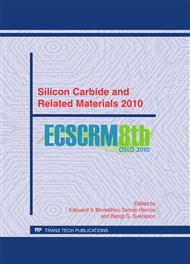p.370
p.374
p.378
p.382
p.386
p.393
p.397
p.401
p.405
Energy Band Structure of SiO2/4H-SiC Interfaces and its Modulation Induced by Intrinsic and Extrinsic Interface Charge Transfer
Abstract:
The energy band structure of SiO2/4H-SiC fabricated on (0001) Si- and (000-1) C-face substrates was investigated by means of synchrotron radiation x-ray photoelectron spectroscopy (SR-XPS). The band structure was found to be dependent on substrate orientation and oxide thickness due to both intrinsic and extrinsic effects that cause charge transfer at the SiO2/SiC interface. Our SR-XPS analysis revealed that the intrinsic conduction band offset of the SiO2/SiC for the C-face substrate is smaller than that for the Si-face. This means that, whereas C-face substrates exhibit high carrier mobility, a problem that is crucial to gate oxide reliability remains for SiC-based metal-oxide-semiconductor (MOS) devices owing to increased leakage current.
Info:
Periodical:
Pages:
386-389
Citation:
Online since:
March 2011
Price:
Сopyright:
© 2011 Trans Tech Publications Ltd. All Rights Reserved
Share:
Citation:


